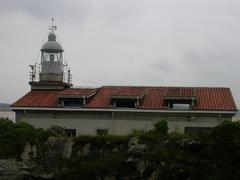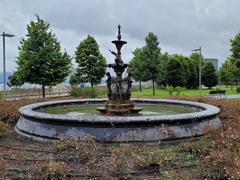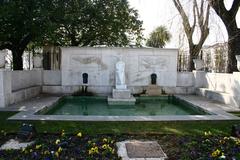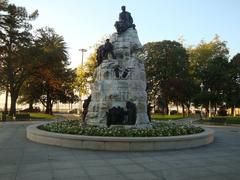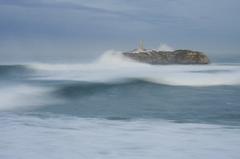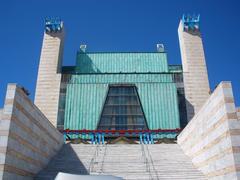University of Cantabria Visiting Hours, Tickets, and Historical Sites in Santander, Spain
Date: 14/06/2025
Introduction: The University of Cantabria and Its Significance in Santander
Santander, the vibrant capital of Cantabria in northern Spain, is celebrated for its blend of historical landmarks, academic institutions, and cultural attractions. Among the city’s most prominent features is the University of Cantabria, recognized for academic excellence and its iconic monument in the city center. The University of Cantabria Monument is both a tribute to the region’s educational heritage and a symbol of innovation, accessible daily with free admission and guided tours on weekends (University of Cantabria Monument).
The university’s campuses, including state-of-the-art research centers like the Institute of Biomedicine and Biotechnology of Cantabria (IBBTEC) and the International Centre for Mathematical Meetings (CIEM), offer visitors the opportunity to engage with contemporary academic culture in a stunning coastal setting (University of Cantabria Official Website).
Santander further delights visitors with historical sites such as the Santander Cathedral—a testament to centuries-old Gothic architecture—and the Magdalena Palace, a royal residence with panoramic views. Both sites are open to visitors with varying hours, guided tour options, and accessible facilities (Santander Cathedral Official Website), (The Magdalena Palace Guide).
This guide presents detailed information on visiting the University of Cantabria, its monument, and surrounding historical and cultural highlights. It covers practical details, history, cultural context, accessibility, and travel tips to help visitors plan a rewarding experience in one of Spain’s most dynamic academic and cultural hubs.
Contents
- Introduction
- University of Cantabria Monument
- History and Cultural Significance
- Visiting Hours and Ticket Information
- Guided Tours and Accessibility
- Nearby Attractions and Travel Tips
- Special Features and Events
- FAQs
- University of Cantabria: Campus Highlights and Visitor Information
- Planning Your Visit
- What to See and Do
- Accessibility and Visitor Services
- Nearby Attractions
- Tips for Visitors
- Santander Cathedral
- Historical Significance
- Visiting Hours and Ticket Information
- Architectural Highlights and Attractions
- Nearby Attractions
- Travel Tips and Accessibility
- FAQs
- Magdalena Palace
- History and Cultural Significance
- Visiting Hours and Ticket Information
- Guided Tours and Visitor Experience
- Accessibility
- Nearby Attractions and Travel Tips
- Special Events and Photo Spots
- FAQs
- Conclusion
University of Cantabria Monument: History, Visitor Information, and Significance
History and Cultural Significance
The University of Cantabria Monument, inaugurated in 1995, stands as a tribute to the university’s enduring impact on education and research in northern Spain. Its artistic design represents knowledge, progress, and the vibrant academic community fostered by the university, making it a notable gathering spot for students, faculty, and visitors.
Visiting Hours and Ticket Information
- Opening Hours: Daily from 9:00 AM to 7:00 PM.
- Admission: Free for all visitors.
- Guided Tours: Weekends at 11:00 AM and 4:00 PM. Advance booking recommended via the Santander tourism website (University of Cantabria Monument).
Guided Tours and Accessibility
Guided tours offer insights into the monument’s history, symbolism, and the university’s milestones. Tours are available in multiple languages and can be booked online. The area is wheelchair accessible and equipped with multilingual informational plaques.
Nearby Attractions and Travel Tips
- Peninsula of Magdalena: Explore the palace and gardens, a 15-minute walk away.
- Santander Cathedral: Visit this Gothic landmark in the city center.
- El Sardinero Beach: A scenic spot for relaxation.
Travel Tips:
- Spring and early autumn offer the most pleasant weather.
- The monument is well-connected to public transport and within walking distance of key city attractions.
Special Features and Events
The monument is central to university events such as commencement ceremonies and cultural festivals. It is also a venue for seasonal light displays and public art installations.
FAQs
Q: Is photography allowed at the monument?
A: Yes, photography is permitted, with designated photo spots.
Q: Are there guided tours?
A: Yes, on weekends; book online for availability.
Q: Is the site accessible for visitors with disabilities?
A: Yes, the monument and surrounding areas are fully accessible.
Q: Can I visit at night?
A: The monument is illuminated after sunset, making for an attractive evening visit.
University of Cantabria: Visitor Information and Campus Highlights
The University of Cantabria (UC) is a leading Spanish academic institution and a destination for visitors interested in research, education, and campus life in a coastal city.
Planning Your Visit
- Location: Main campus in Santander with additional sites in Torrelavega and Comillas.
- Visiting Hours: Outdoor areas are open during daylight. Access to specific facilities, such as libraries or labs, may require prior arrangement.
- Tickets: Outdoor campus access is free. Some events or research center tours may require registration.
What to See and Do
- Campus Tours: Guided tours, when available, introduce the university’s architecture, history, and academic culture.
- Academic Events: Public lectures, workshops, and conferences are regularly held—check the university’s events calendar.
- Research Centers:
- Institute of Biomedicine and Biotechnology of Cantabria (IBBTEC): Focus on biomedical research.
- International Centre for Mathematical Meetings (CIEM): Hosts international mathematics conferences.
Accessibility and Visitor Services
- Language: Most undergraduate programs are in Spanish; many postgraduate courses are in English, particularly in STEM fields.
- Facilities: Visitors may access cafeterias, study areas, and Wi-Fi. Contact the international office for access to research facilities.
- Support: The international office can assist with visitor arrangements and provide personalized guidance.
Nearby Attractions
- Palacio de la Magdalena
- Santander Beaches
- Museum of Prehistory and Archaeology of Cantabria
Tips for Visitors
- Check the university official website for the latest visitor guidelines and event schedules.
- Weekday visits are ideal when most facilities are open.
- Contact the international office for tailored advice.
Santander Cathedral: A Historic and Architectural Treasure
Historical Significance
Santander Cathedral, officially the Metropolitan Cathedral Basilica of the Assumption of the Virgin Mary, is a central landmark tracing its origins to the 12th century. Initially a Romanesque church, it evolved into a Gothic structure during the 13th and 14th centuries and has endured significant historical events, including restoration following the 1941 fire. The cathedral’s architectural blend and preserved artworks offer a window into Santander’s past (Santander Cathedral Official Website).
Visiting Hours and Ticket Information
- Hours:
- Monday to Saturday: 10:00 AM – 6:30 PM
- Sundays & Public Holidays: 12:00 PM – 6:00 PM
- Admission:
- General admission: Free
- Guided tours: €5 per person
- Audio guides: €3
- Discounts for students, seniors, and groups are available.
Tickets can be purchased at the entrance or online.
Architectural Highlights
- Gothic Nave and Chapels: Admire vaulted ceilings and stained glass.
- Cloister: A tranquil 14th-century courtyard.
- Treasury Museum: Displays religious artifacts.
- Bell Tower: Offers panoramic city and coastline views.
Nearby Attractions
- Palacio de la Magdalena
- Santander Beaches
- Museum of Prehistory and Archaeology of Cantabria
These sites offer a comprehensive cultural experience.
Travel Tips and Accessibility
- Transportation: Located centrally and accessible by public transport or on foot.
- Accessibility: Ramps and assistance are available for visitors with mobility needs.
- Best Time to Visit: Early mornings or late afternoons for fewer crowds.
- Photography: Permitted without flash or tripods.
FAQs
Q: Is the cathedral open during services?
A: Yes, though visitor access may be limited during ceremonies.
Q: Are guided tours multilingual?
A: Tours are offered in Spanish and English; other languages upon request.
Q: Can special events or weddings be held at the cathedral?
A: Yes, by arrangement with cathedral authorities.
Q: Is parking nearby?
A: Public parking is available within walking distance.
The Magdalena Palace: A Regal Landmark
History and Cultural Significance
Built between 1908 and 1912, the Magdalena Palace was a summer residence for the Spanish royal family. Its architecture reflects English, French, and Cantabrian influences, and today it hosts cultural events, conferences, and public tours (The Magdalena Palace Guide).
Visiting Hours and Ticket Information
- Hours: Tuesday–Sunday, 10:00 AM–6:00 PM; closed Mondays and public holidays.
- Tickets:
- Adults: €6
- Students/Seniors: €3
- Children under 12: Free
- Guided tours: Additional €4
Tickets can be purchased online or at the entrance; advance booking is advised during peak season.
Guided Tours and Visitor Experience
Guided tours (Spanish, English, French) last about 45 minutes. Audio guides are available for self-paced exploration.
Accessibility
The palace is wheelchair accessible with ramps and adapted restrooms. Contact the visitor center for assistance.
Nearby Attractions and Travel Tips
- Santander Beaches: Playa del Sardinero is nearby.
- Centro Botín: Contemporary art center with exhibitions and events.
- Museum of Prehistory and Archaeology of Cantabria: A short drive away.
Travel Tips:
- Visit in spring or autumn for the best weather.
- Wear comfortable footwear for exploring the grounds.
- Combine your palace visit with a waterfront stroll.
Special Events and Photo Spots
The palace hosts concerts, art exhibitions, and festivals. Top photo spots include the main façade, terrace views of the bay, and the landscaped gardens.
FAQs
Q: Are pets allowed?
A: Only service animals are permitted inside.
Q: Is photography allowed?
A: Yes, without flash in most areas; some rooms may have restrictions.
Q: Can I book private events?
A: Yes, contact the administration for details.
Q: Is the palace family-friendly?
A: Yes, with educational materials for children.
Summary: Key Points for Visitors
Visiting the University of Cantabria and its monument offers a unique glimpse into the academic and cultural life of Santander. The monument stands as a symbol of educational values and progress, while the university’s campuses welcome visitors interested in academic tourism, research, and campus culture. Complementing the university experience, Santander’s historical sites—particularly the Cathedral and the Magdalena Palace—create a diverse itinerary for travelers seeking history, architecture, and scenic beauty.
Accessible visiting hours, guided tours, and a lively calendar of cultural events ensure that every visitor can enjoy Santander’s academic and historical offerings. For the latest information and exclusive content, consult official websites and consider downloading the Audiala app.
References and Further Reading
- The Magdalena Palace in Santander: Visiting Hours, Tickets, and Guide to Historical Sites, 2025, Audiala (https://www.turismodecantabria.com)
- University of Cantabria Monument: Visitor Guide, History, and Significance, 2025, Santander Tourism (https://www.turismodecantabria.com)
- Santander Cathedral: Visitor Guide to a Historic Monument, 2025, Santander Cathedral Official Website (https://www.catedraldesantander.com)
- Visiting the University of Cantabria: A Guide for Academic Tourists and Visitors, 2025, University of Cantabria (http://www.unican.es/en)
